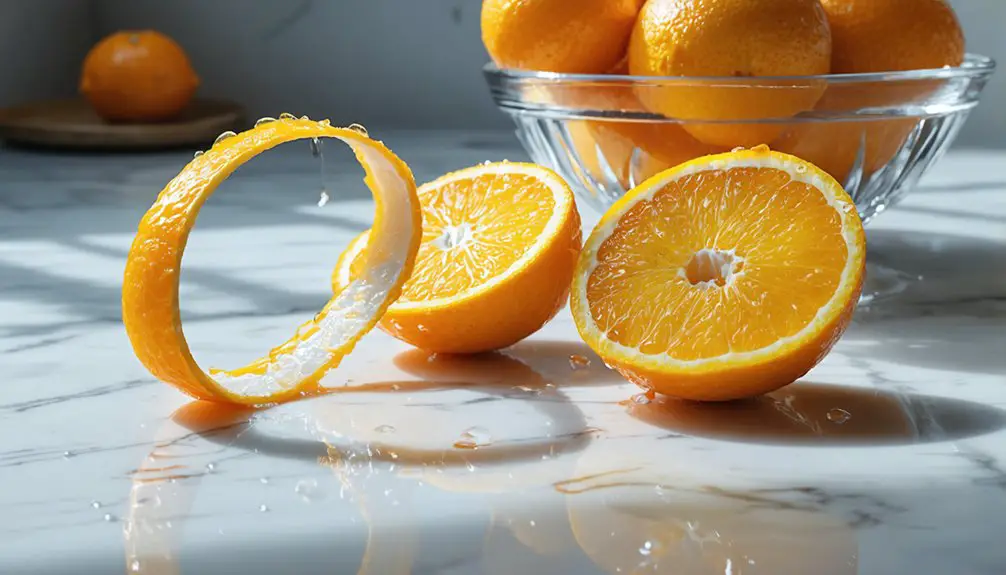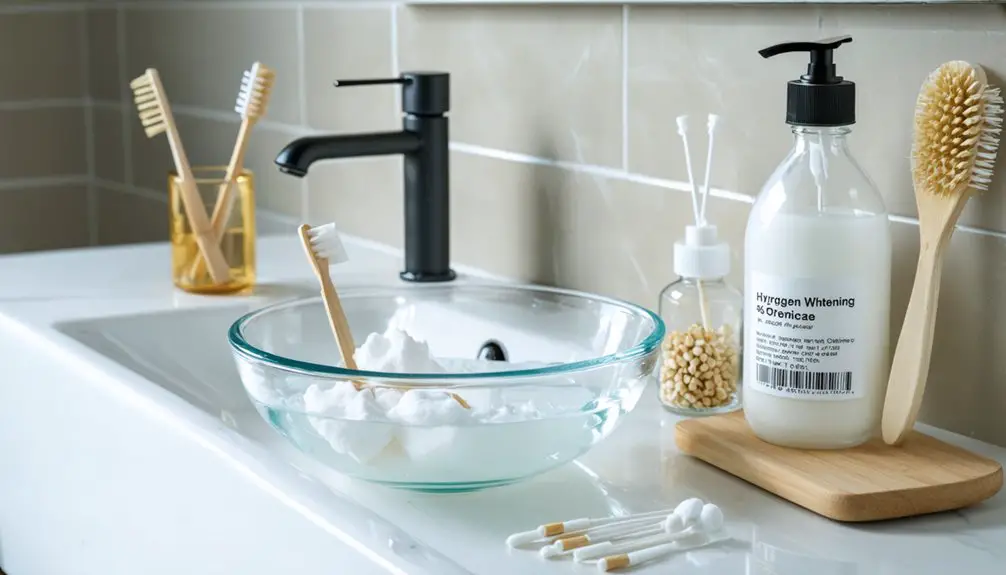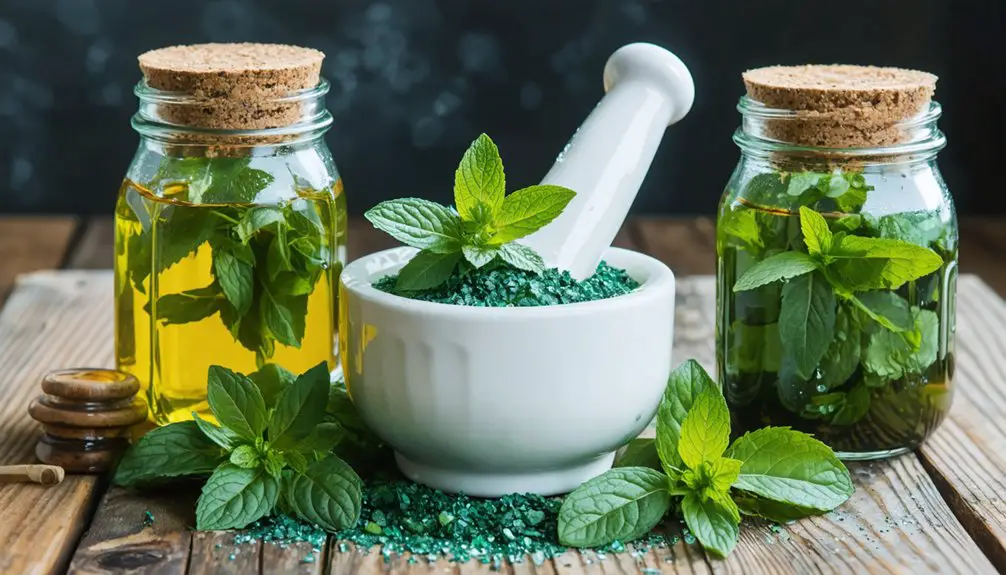While orange peels offer natural whitening compounds like citric acid and d-limonene that can help remove surface stains, you’ll want to use them cautiously to protect your tooth enamel. For a gentle approach, try rubbing the white inner peel on your teeth for 2-3 minutes, no more than twice weekly. Always rinse thoroughly afterward and follow with fluoride mouthwash. Discover how to safely harness nature’s whitening power while keeping your smile healthy.
Key Takeaways
- Orange peels contain natural whitening compounds like citric acid and d-limonene that help remove surface stains from teeth.
- Gently rub the white inner side of organic orange peels directly on teeth for 2-3 minutes, no more than twice weekly.
- Always rinse thoroughly after using orange peels and follow with fluoridated mouthwash to protect tooth enamel.
- Combine orange peel treatments with preventive measures like avoiding dark beverages and using whitening toothpaste.
- Consider safer alternatives like baking soda or professional treatments, as orange peels’ acidity may damage tooth enamel over time.
The Science Behind Orange Peel Whitening
While many people turn to expensive commercial whitening treatments, the natural compounds in orange peels offer a gentler approach to brightening your smile.
The key chemical compounds responsible for this whitening effect are citric acid and d-limonene, which work together through multiple whitening mechanisms to help remove surface stains from your teeth.
When you apply orange peel to your teeth, the citric acid gently etches the enamel surface while d-limonene acts as a natural solvent to dissolve stubborn stains.
These compounds can alter your tooth’s surface chemistry to enhance light reflection, creating a whiter appearance.
Research shows that using a 5% concentration level of citric acid extracted from citrus peels provides optimal whitening results.
While not as powerful as commercial bleaching agents, orange peel’s natural composition provides a balanced approach to teeth whitening that you can safely incorporate into your oral care routine. However, prolonged use of citrus-based remedies can be problematic as citrus fruits can wear away tooth enamel over time.
Safety Concerns and Potential Risks
Natural remedies can be appealing, but orange peel teeth whitening comes with important safety considerations you should understand. The citric acid in orange peels can cause enamel erosion, weakening your teeth and making them more vulnerable to decay over time. Studies suggest no-sugar orange juice still causes significant enamel damage.
While orange peels may seem like a natural whitening solution, their citric acid content can permanently damage your tooth enamel.
You’ll want to be particularly mindful of potential gum irritation and tooth sensitivity that may develop from repeated use. While some believe oranges contain bleaching properties similar to lemons, this claim lacks scientific evidence.
While orange peels might offer some surface stain removal, they lack the safety controls found in professional treatments. The acidic nature can disrupt your mouth’s natural bacterial balance and potentially harm your oral microbiome.
To protect your dental health, it’s wise to consult with a dental professional before trying this remedy, as they can guide you toward safer whitening alternatives that won’t compromise your enamel or gum health.
Proper Application Methods and Best Practices
To safely harness the whitening properties of orange peels, proper preparation and application techniques are essential. Start by selecting organic orange peels and either dry and powder them or use fresh pieces, ensuring you’re working with the white inner pith side.
When applying, you’ve got two main options: either dip your wet toothbrush in orange peel powder or gently rub the peel’s inner white portion directly on your teeth. The natural compound limonene in orange peels works to break down surface stains while providing a fresh scent.
Follow frequency guidelines by limiting use to 2-3 times weekly, and always apply during daytime hours when you can properly rinse afterward. Keep application time to 2-3 minutes maximum, using gentle circular motions. Good oral hygiene combined with consistent after-meal brushing helps maintain results longer.
After treatment, rinse thoroughly and follow with fluoridated mouthwash to protect your enamel. Remember to maintain your regular oral hygiene routine alongside these natural whitening sessions.
Alternative Natural Teeth Whitening Options
Beyond orange peels, several other kitchen ingredients can brighten your smile effectively and safely. You’ll find baking soda particularly effective due to its gentle abrasive properties that lift surface stains while protecting your enamel.
Professional dental experts recommend avoiding dark-colored beverages to prevent new stains from developing. Like other citrus benefits, strawberries contain natural acids that help remove discoloration, though they’re milder than chemical treatments.
For a holistic approach, try oil pulling with coconut oil, which helps reduce bacteria that cause yellowing. Research shows 1.5% to 3% hydrogen peroxide solutions can safely whiten teeth when used a few times weekly. You can also incorporate crunchy fruits and vegetables as natural abrasives – apples, carrots, and celery work as nature’s toothbrushes while promoting healthy saliva flow.
Remember to rinse your mouth after consuming staining beverages like coffee or red wine to maintain your results. These natural options support both your oral health and a brighter smile.
Professional Recommendations and Guidelines
While orange peels offer natural compounds that may temporarily brighten teeth, dental professionals strongly caution against their direct use for whitening.
The citric acid content in orange peels could potentially damage tooth enamel with repeated use.
Dental supervision ensures safer and more effective whitening results compared to DIY methods.
To protect your dental health, you’ll want to contemplate safer, clinically-proven alternatives under professional guidance.
If you’re seeking natural approaches to teeth whitening, focus on prevention first. You can maintain your smile’s brightness by immediately rinsing after consuming staining beverages and using dentist-approved whitening toothpaste.
For more significant results, schedule a consultation with your dentist, who can recommend appropriate treatments based on your specific oral health needs.
Frequently Asked Questions
Can Orange Peel Whitening Remove Deep Stains From Medications or Dental Procedures?
No, orange peel effectiveness doesn’t extend to deep stain removal from medications or dental work. You’ll need professional treatment for those stubborn discolorations, as natural remedies can’t penetrate beyond surface stains.
How Long Should I Wait After Professional Teeth Cleaning Before Using Orange Peels?
You’ll need to wait 24-48 hours after professional cleaning as a post-cleaning precaution. This ideal waiting period allows your enamel to re-harden and helps prevent potential sensitivity or damage.
Will Orange Peel Whitening Affect Tooth Fillings, Crowns, or Dental Bonding Materials?
Don’t use orange peels if you’ve got tooth restorations – they can damage your fillings, crowns, and bonding materials. For dental safety, consult your dentist about professional whitening alternatives instead.
Can Children or Teenagers Safely Use Orange Peels for Teeth Whitening?
Like a shield protecting young smiles, you shouldn’t use orange peels for children’s dental health or teenage oral hygiene. The acid can damage developing teeth. Wait until age 18 for any whitening treatments.
Does Combining Orange Peels With Coconut Oil Improve Whitening Results?
While coconut oil benefits and orange peel properties may work together to improve oral health, there’s no scientific proof they enhance whitening results when combined. You’ll want professional guidance for best results.
References
- https://www.natrusmile.com/blogs/news/do-orange-peels-whiten-teeth
- https://www.deltadental.com/grinmag/us/en/ddma/2019/summer/dental-benefits/dental-trend-spotlight-banana-peel.html
- https://www.shortpumpdental.com/our-blog/the-truth-about-natural-teeth-whitening-fads
- https://crest.com/en-us/oral-care-tips/teeth-whitening/natural-teeth-whitening-options-are-they-effective
- https://faycurrydental.com/debunking-the-myths-of-natural-whitening-trends-insights-from-jeffrey-b-faycurry-dds-your-trusted-dentist-in-rochester-hills/
- http://ui.adsabs.harvard.edu/abs/2017JPhCS.824a2071P/abstract
- https://www.science.gov/topicpages/t/tooth+whitening+effect.html
- https://pmc.ncbi.nlm.nih.gov/articles/PMC9645194/
- https://pmc.ncbi.nlm.nih.gov/articles/PMC6369603/
- https://medicaldialogues.in/fact-check/fact-check-can-orange-peel-whiten-teeth-134992



